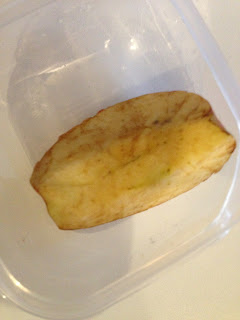We all know that getting kids to wash their hands and brush their teeth can sometimes be a bit of a battle. After all - their teeth and hands look clean, so why should they clean them? It's pretty hard to explain the concept of "germs" when the kids can't see them. It's also hard to rationalize with a 3 year old who has gone from brushing his teeth without us telling him to - to not brushing at all... All because someone told him "the tooth fairy comes when your teeth fall out! I want my teeth to fall out so the tooth fairy comes!"... Ahh the joys!
I stumbled on two experiments which I thought were great ideas on why it's important to wash our hands and brush our teeth.
Egg Teeth
What you need:
4 eggs - all ours were raw but you can boil 3 and leave 1 raw if you like
3 dark drinks/foods - we used coffee, cranberry juice and melted chocolate.. You can use anything you have handy (eg. other juices, dark sauce etc.)
Vinegar
OK so with this experiment I had to set the scene. I told the kids to pretend that eggs were our teeth. I held them up to my mouth with a big smile and said "look at my teeth!" It must have looked quite the sight but they quickly understood and asked to hold the eggs close to their mouths too. I had to remind them to hold the eggs carefully because they were still raw. After showing off their egg teeth with a giggle, it was time to get on with the experiment.
We filled a small bowl with a different liquid/food.
(Top left) Cranberry juice, (top right) Vinegar, (bottom left) melted chocolate, (bottom right) instant coffee.
Then the kids put the eggs into each bowl (if you have boiled some of the eggs, put a raw one in the vinegar).
Over the course of about 2 days, we observed the changes that happened.
These are some of their observations...
The vinegar and the cranberry juice bubbled up when we put the egg inside.
After a couple of days the eggs that were in the cranberry juice and the instant coffee had turned a different colour.
The melted chocolate had stuck to the egg.
Now the fun part!
We put all of the eggs onto a tray (I wasn't brave enough to give it to them to hold by themselves - especially because I had made a conscious decision not to cook the eggs!!).
"Look mummy this egg is brown. This egg has hard chocolate on it! Can I eat the chocolate?" Hahaha... umm noooo :)
"Yuuuuuck! The vinegar made the teeth go soft!" The shell on the egg literally fell open, and it felt kind of rubbery. I've seen other people who have done this experiment and they kept it in the vinegar for longer - the vinegar literally disintegrated the shell and cooked the egg!!
Then we got out some old toothbrushes - as they carefully cleaned the "teeth" with a toothbrush and toothpaste I explained that all foods stay on our teeth unless we brush them. Different foods or drinks can change the colour of our teeth if we don't brush them regularly and other foods - like chocolate - can stick to our teeth and damage them.
Mr. 2 and a half year old "no I don't want to brush my teeth" - now excitedly tells me (after everything he puts in his mouth), "mummy we need to brush our teeth so the food doesn't stay on there!"... Oh and Mr 3 year old who wants the tooth fairy to come is now happy to wait until his teeth fall out naturally - because the tooth fairy only comes for clean teeth ;)
Aha! Mission "Healthy Teeth" a success!
Apple Germs!
All you need is 2 apple slices and 2 small containers or glass jars.
Put one piece of apple in a container in the lid. Explain to the kids that this is a clean apple that has no germs on it.
With the other slice, get them to touch it for about a minute each (make sure they have not just washed their hands - they need dirty hands for this one!). This experiment would work awesome in a classroom because the end result would be a lot more dramatic!
We left the apple slices for about 6 days and observed the results.
The end product?
Self explanatory! ;)
Wash your hands, kids! Germs are there - we can't see them but they are really there! The proof is in the apple!!
Did the experiments have a lasting affect on my kids?
Yes - they are both now happily brushing their teeth - it is not a chore... And they are both washing their hands (even though they need reminding - difference being is that I don't have to ask them 5 times before they actually do it!). It has only been a week - I wonder how long it will last?? I'll keep you updated!































































